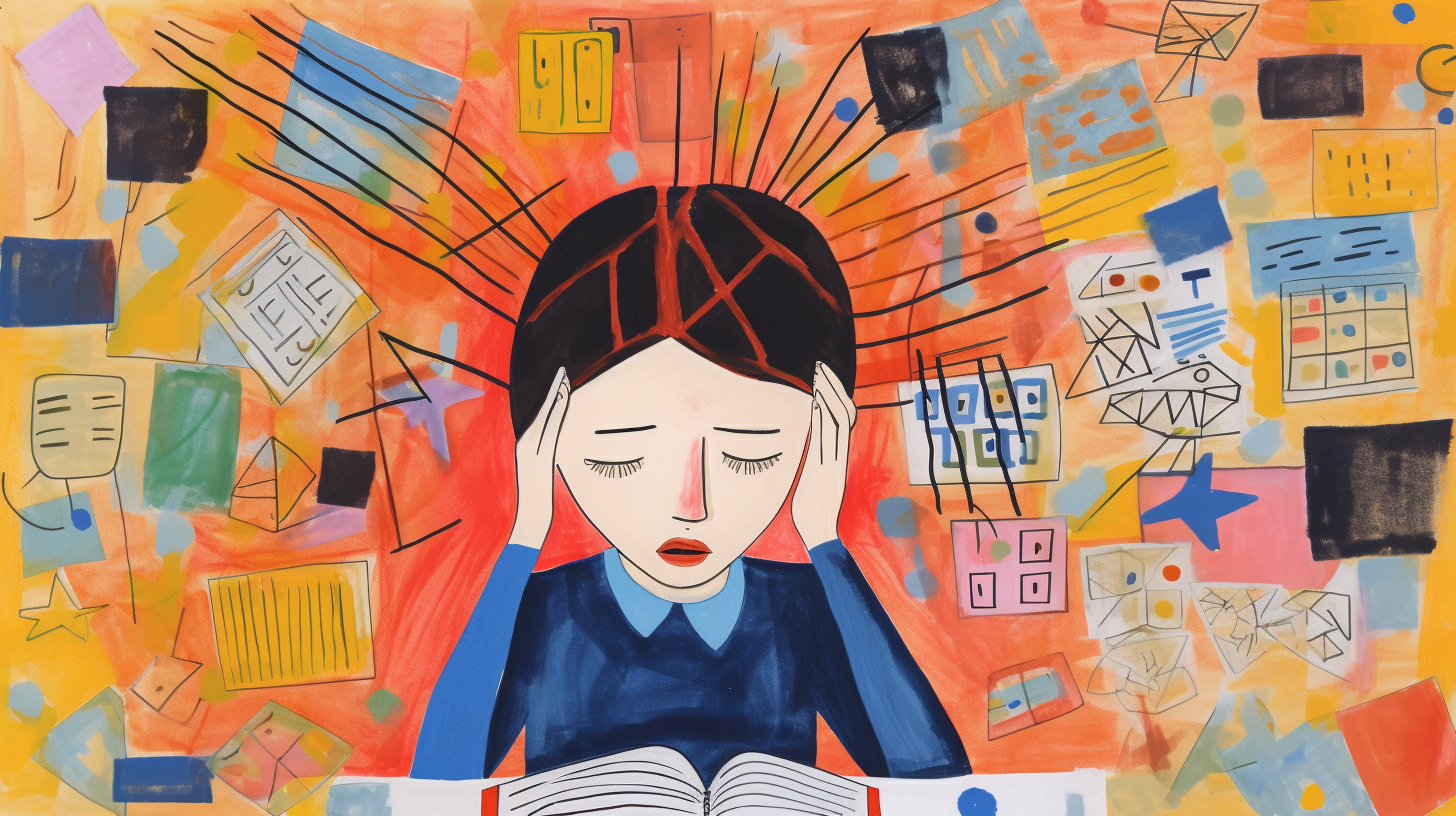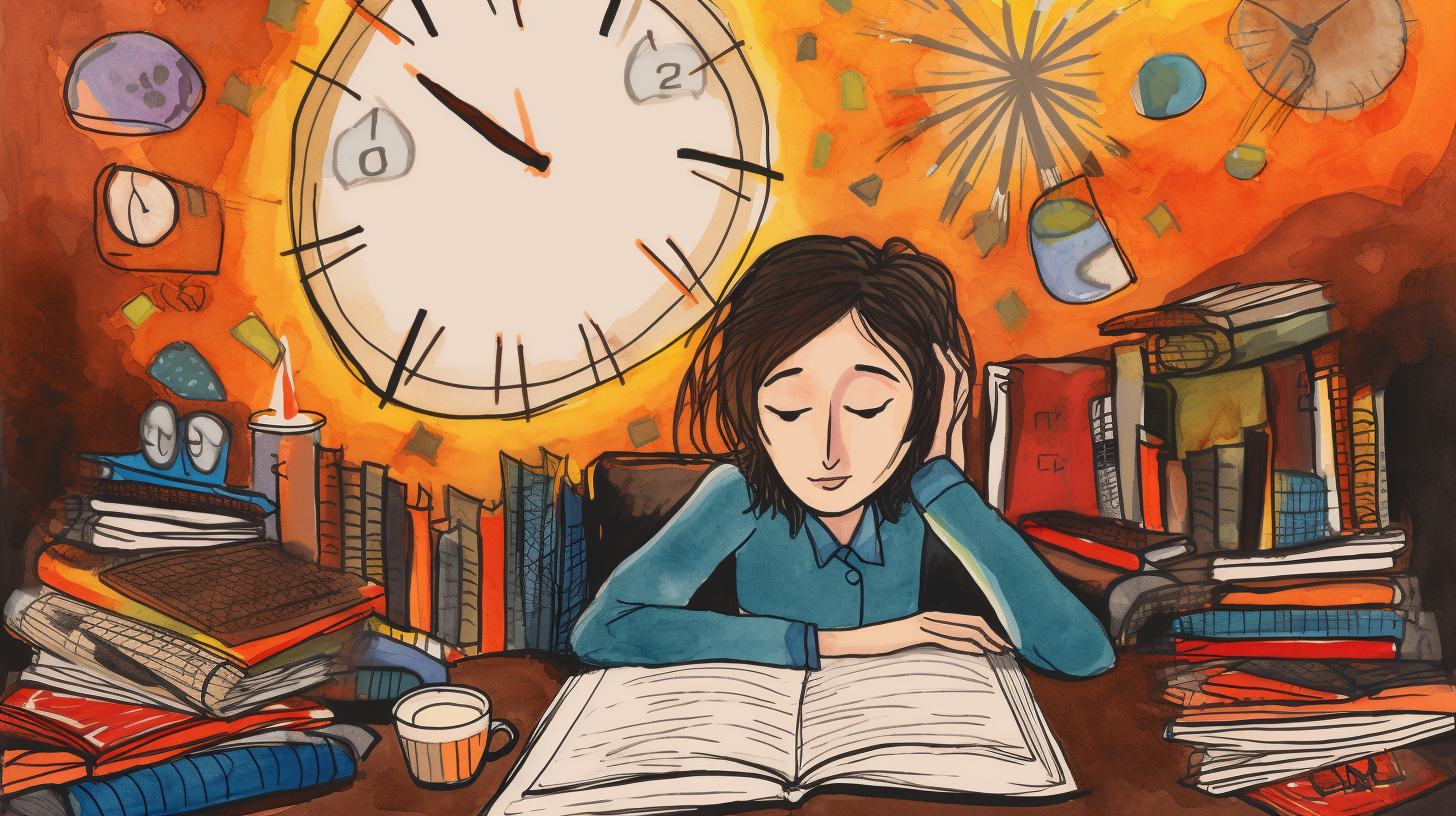Found yourself rubbing your temples during a reading marathon? A headache when reading can turn a delightful hobby into a painful chore. But before you ditch the books, know that reading isn’t often the real culprit. In this text, we’ll explore the common causes of headaches when reading, shedding light on how visual stress and eyestrain contribute to your discomfort.
We’ll also investigate the role poor lighting plays in exacerbating headaches and how your reading posture might be putting unnecessary strain on your body. Stay tuned as we unpack these factors and offer solutions to keep your reading sessions enjoyable and pain-free.
Common Causes of Headaches when Reading
You might be wondering if that headache when reading could be more than just a random occurrence. It’s not just in your head—or rather, it is, but there’s a reason. Eye strain headache is a real issue that can affect avid readers like you. This type of discomfort, commonly known as an eyestrain headache, could result from prolonged focus on text, leading to headaches caused by eye strain.
Eye Strain: A Leading Factor
When you spend a lot of time reading, your eyes work overtime. This can often lead to eye strain, causing headaches. The symptoms can be unmistakable: your eyes hurt, and you might experience a headache and eye strain combo, making focusing challenging. It’s quite common to ask yourself, “Can eye strain cause headaches?” The answer is yes—eyesight headaches are frequently reported by individuals who engage in extensive reading sessions without proper breaks.
How Lighting Affects Your Eyes
Poor lighting is another culprit that could be contributing to that headache from reading. Imagine this: You’re absorbed in a book while the light slowly fades, and you strain to see the words. This unnecessary effort can lead to a headache due to eye strain. If your eyes hurt and headaches become issues under dim or harsh lighting conditions, it’s time to reassess your environment.
Posture and Visual Stress
Don’t overlook your reading posture, as it plays a significant role in your feelings. Lousy posture can impact your back and add to visual stress, leading to headaches from eye strain. Similarly, if your text is too small or there’s any glare on the page, you might experience an eyestrain tension headache. Ask yourself if you’re squinting or adjusting your body to see the text better, as these are signs that your body is compensating for visual stress.
You’re one step closer to alleviating those eye strain headaches by identifying these common issues. Remember that frequent breaks, proper lighting, and comfortable posture can make all the difference to your reading experience—and reduce the chance of an eye strain migraine. Keep tuning in to learn more about creating an optimal reading space that keeps the focus on enjoyment, not discomfort.
Visual Stress
Symptoms of Visual Stress
When you’re experiencing visual stress, a range of symptoms might manifest, making reading a challenging task. Eye strain headaches often present as a telltale sign; you might notice the words on the page start to shimmer or flicker. Some people describe a feeling where lines seem to curve or blur, while others may report seeing colors or shapes that aren’t on the page. This isn’t unusual; eyes and headaches often pair up to signal that your visual system is under undue pressure. If you’ve ever had a headache from reading or noticed that your eyes are hurting and you have a headache, you’ve likely encountered visual stress.
Symptoms might sometimes escalate to an eye strain migraine, especially if you continue the activity causing the strain. It’s essential to recognize whether these occurrences are isolated incidents or if they represent a recurring problem. Can eye strain cause headaches? Bleaches due to eye strain can significantly impact your daily comfort and productivity. If your head and eyes hurt after reading, consider that visual stress might be at play.
Solutions for Visual Stress
Efficient solutions to mitigate the discomfort of visual stress focus on minimizing the triggers. Opting for audiobooks, for instance, eliminates the visual component, paving the way for a headache-free experience. You can rest your eyes while still indulging in the latest bestseller or a timeless classic. Audiobooks relieve symptoms like headache and eye strain and can also be enjoyed while multitasking or relaxing, offering unparalleled convenience.
If you’re not listening to an audiobook and choose to read, consider these adjustments:
- Modulate Lighting: Ensure the lighting in your room matches the brightness of your book; this prevents you from straining to see the text.
- 20-20-20 Rule: To avoid an eye strain headache, adopt the 20-20-20 rule: every 20 minutes, look at least 20 feet away for 20 seconds to rest your eyes.
- Reading Aids: Tools such as cards with reading slots can help by allowing only a portion of the text to be visible, thus reducing eye strain.
Remember, consistent headaches from eye strain or any change in your vision warrant a checkup from an eye care professional, as they could suggest an eye problem causing headaches. Regular breaks, good lighting, and potentially switching to audiobooks can significantly reduce or eliminate your headaches when reading.
Eyestrain
When your eyes work too hard, eyestrain becomes imminent. It’s often the culprit behind that nagging headache when reading. It might surprise you, but your discomfort could be an eye strain headache. This is one of those moments when opting for an audiobook could give your eyes a break and enhance your enjoyment of literature without any accompanying pain.
Signs of Eyestrain
If you’re experiencing a headache from reading, you might be dealing with eyestrain. Can eye strain cause headaches? Absolutely. The list of symptoms includes:
- Tired eyes
- Dry or watery eyes
- Blurred or double vision
- Soreness in or around the eyes
- Sensitivity to light
- Difficulty concentrating
- Neck and shoulder pain
Eye strain migraines and tension headaches can arise from prolonged focus on print or digital screens. Your body signals that it’s time to rest your eyes. Take a moment to assess your symptoms. Do your eyes hurt when reading? If they do, the headaches you’re experiencing could be eyesight headaches, where your visual efforts lead to discomfort.
Tips to Reduce Eyestrain
Reducing eyestrain is essential for avoiding the headaches it induces. If you’ve wondered, ‘can reading cause Candaches?’, know that it’s not the act itself, but how you do it. Here are direct actions to help:
- Position reading material comfortably, ideally 20 to 25 inches from your eyes.
- Ensure ample lighting in your space, avoiding harsh glares.
- Increase text size to prevent squinting.
- Blink regularly to moisten your eyes, reducing dryness.
- Take frequent breaks using the 20-20-20 rule: every 20 minutes, look at something 20 feet away for at least 20 seconds.
- Adjust posture to relieve tension in the neck and shoulders.
Headaches from eye strain can detract from the pleasure of reading. But what if you gave your eyes a respite? Audiobooks are a fantastic alternative, absorbing you into the story without the risk of an eyestrain headache. With audiobooks, eye strain causing headaches becomes a non-issue. They offer the joy of a good book minus the pain and are easy on your eyes, making them an ideal solution for those prone to eyestrain headaches.
So, next time you face a headache and eye strain from diving into your favorite book, consider the audiobook experience. It’s not just a matter of convenience but also a form of self-care, where you prioritize your comfort and health while still indulging in your love for stories.
Poor Lighting
Effects of Poor Lighting
When you’re curled up with a good book, the last thing you want is a headache ruining your experience. Eye Strain Headaches are often the culprits, and they can transform a relaxing pastime into an ordeal. Poor lighting conditions exacerbate the problem, as they cause your eyes to work harder to focus. This additional effort leads to Eye Strain Migraine symptoms like blurry vision, discomfort, and those nagging Eye Strain Headaches that can dampen your mood.
If you’ve ever wondered, “Can Eye Problems Cause Headaches?” the answer is yes. When faced with inadequate lighting, your pupils dilate, and in doing so, they put strain on your eye muscles. The constant need to adjust to the dark environment triggers eyeaches and Headaches, signaling that Your Eyes are under too much pressure. Headaches Caused by Eye Strain reflect your visual system’s call for better conditions.
Improving Lighting Conditions
Adjust the lighting in your reading nook to stave off those Eye Strain Tension Headaches. Ensure Your Eyes don’t have to strain by providing a well-lit space. Here’s what you can do to prevent Eye Strain Headaches:
- Use task lighting to spotlight your reading area without overwhelming the rest of the room. – The ambient light should be bright enough so that there’s no stark contrast, as this reduces the Headache When Reading.
- Avoid direct glare, which can lead to Headaches From Bad Vision; position lamps to bounce light off walls for a softer effect.
Remember, while traditional reading has its place, audiobooks offer a reprieve from the visual demands that cause Eyesight Headaches. You’re not just giving your eyes a break; you’re opening a world where Headaches From Reading are a thing of the past.
Engage effortlessly with stories without the worry of Eyes Causing Headaches through the power of audiobooks. Whether you’re looking to dodge the Headache and Eye Strain of a page-turner or integrate books into your busy lifestyle, audiobooks are your ally in conquering Eye Strain Cause Headaches quickly and conveniently.
Incorrect Reading Posture
Impact of Incorrect Reading Posture
When you settle into your favorite reading spot, the position you assume may seem insignificant, but it’s far from trivial. Incorrect reading posture can contribute to eye strain headaches, which often deter you from enjoying the activity. Headaches from reading are not merely a nuisance; they signify that your eyes and body are under unnecessary stress. Your eyes work in concert with your neck and shoulders to maintain focus on the text, and poor posture can lead to eyestrain headaches.
Sustaining an awkward angle with your neck or reading with the material too far or too close forces your eye muscles to overcompensate, potentially causing headaches. Eye strain and headaches are interlinked; one can exacerbate the other in a vicious cycle. Also, prolonged poor posture while reading can shift from eyestrain headaches to tension headaches, further affecting your overall comfort and concentration.
Correcting Reading Posture
To prevent headaches from eye strain, optimizing your reading environment and posture is vital. Ensure that your reading material is at eye level to avoid tilting your head downward or upward, as this can strain your eyes and neck. Keeping the material at a comfortable distance is essential – not too close to induce eye strain nor too far to make your eyes work harder. Proper back support is vital to avoiding slouching. Maintain a straight, supported spine to reduce the risk of eye strain causing headaches. Also, take frequent breaks to relax your eye muscles and prevent eyestrain migraine. During these breaks, looking at objects at various distances can help reduce the eye strain tension headache associated with static focus.
It’s worth mentioning that if you’re one of the many who experience headaches when reading, audiobooks present an effective alternative. They eliminate the risk of eye strain headaches, offering a chance to rest your eyes while indulging in stories and information. This adjustment can reduce the frequency of eye aches and headaches, giving your eyes and mind a much-needed respite.
By being mindful of these adjustments and considering the switch to audiobooks, your reading routine can become more pleasurable and less painful. Whether you’re diving into fiction or exploring new knowledge, keeping headaches caused by eye strain at bay is crucial for a sustained and enjoyable reading experience.
Conclusion
You’ve got the power to transform your reading experience from painful to pleasurable. You’re on track to bid farewell to those nagging headaches by tweaking your lighting and posture. Remember to keep your reading material at just the right level and distance, and don’t forget to give your eyes a well-deserved break now and then. If traditional reading still doesn’t sit right, audiobooks are your friend. They’re easy on the eyes and can enrich your experience with their unique charm. Here’s to enjoying your next book headache-free!
Frequently Asked Questions
Why can poor lighting cause eyestrain headaches when reading?
Poor lighting makes it difficult for the eyes to focus, leading to overexertion. This additional strain on the eyes can result in symptoms that include headaches.
How can improving lighting conditions help prevent eyestrain headaches?
Improving lighting conditions, such as using task lighting and avoiding direct glare, reduces eyestrain by providing consistent and sufficient light, which helps the eyes focus with less effort.
Can audiobooks be a solution to prevent eyestrain headaches?
Yes, audiobooks can prevent eyestrain headaches by eliminating the need for visual focus, thus reducing the strain on the eyes associated with reading text.
Why is correct reading posture important to prevent eyestrain headaches?
Correct reading posture aligns the body properly, which helps reduce tension in the neck and shoulders, which can contribute to headaches, and ensures the reading material is at the optimal distance and angle.
What are some tips for optimizing the reading environment and posture?
Tips for optimizing reading environment and posture include keeping reading material at eye level, maintaining a comfortable distance between your eyes and the text, and taking frequent breaks to rest your eyes.




